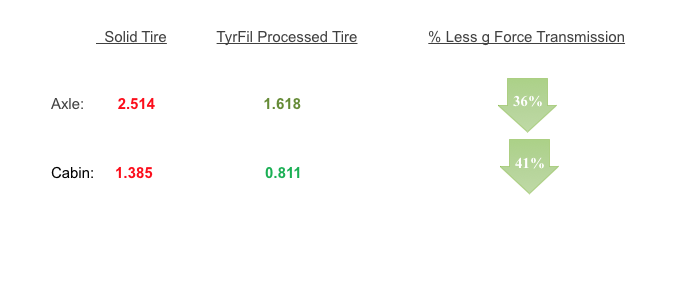TyrFil™ VS Solids
Carlisle TyrFil™ Systems 26.5X25 Filled vs. Solid tire g force test
June 12, 2016
Test Facility:
Testing was conducted and supervised by the Transportation Research Center, East Liberty Ohio, on three test courses.
Test team participants:
Transportation Research Center, Project Number 20160299 –
Ryan McGaughey, Project Engineer Research & Development
Accella Tire Fill Systems –
Roeland Tuinman, PhD., R&D Technical Manager
Mike Fullen, Executive Director of Aftermarket Sales
Bob Rose, Senior Chemist & Technical Consultant
Keith Cartwright, Field Service Technician
Lance Hanson, Field Service Technician
Whole Body Vibration (WBV) Consultant –
Helmut Paschold, PhD., CSP, CIH
Assistant Professor, Department of Safety Sciences
Indiana University of Pennsylvania
Background:
Dr. Helmut Paschold, in his analysis brief, offered the following:
“Vibration transmitted to a vehicle is of great concern. Exposure to constant and severe vibrations will ultimately cause premature fatigue and damage the vehicle components. As vehicles are operated by a riding driver, the effects of vibration on the human component cannot be ignored. The road surface, vehicle components/configuration, and operating speed/style contribute to vibrations within the system. These vibrations are transmitted to the driver from a chassis mounted seat. Reduction of vibration in the vehicle will ultimately reduce the vibration exposure transmitted to the operator.
Environmental WBV is transmitted from the contact surface to the whole human body while standing, sitting or reclining. Occupational seated exposure is found with operators of a variety of vehicle categories such as cars, buses, fork-lifts, tractors, trucks and heavy machinery either on or off paved roads (Padden & Griffin, 2002). Locomotive engineers are also exposed to significant levels of WBV (Johanning, et al., 2006).
While WBV is not a part of current OSHA standards, the National Institute of Occupational Safety and Health (NIOSH) has conducted research in the area of WBV. In its conclusions about WBV, NIOSH (1997) states,
‘Laboratory studies have demonstrated WBV effects on the vertebra, intervertebral discs, and supporting musculature. Both experimental and epidemiologic evidence suggests that WBV may act in combination with other work-related factors such as prolonged sitting, lifting, and awkward postures to cause increased risk of back disorder.’ (p. 6-33)”
Johanning, E., Landsbergis, P., Fischer, S., Christ, E., Göres, B., & Luhrman, R. (2006). Whole-body vibration and ergonomic study of US railroad locomotives. Journal of Sound and Vibration, 298(31), 594-600.
National Institute of Occupational Safety and Health (NIOSH). (1997). Musculoskeletal Disorders and Workplace Factors. DHHS (NIOSH) Publication No. 97-141.
Paddan, G. S. & Griffin, M. J. (2002). Evaluation of whole-body vibration in vehicles. Journal of Sound and Vibration, 253(1), 195-213.
Testing:
Test Vehicle – Caterpillar 966G Wheel Loader
Tires –
- 26.5X25 New Firestone L5 Slick with Carlisle TyrFil™ @ 55psi.
- 26.5X25 New Revolution Solid Aperture
Test Description – Accelerometers were placed on each axle, measuring acceleration in the x, y, and, z axes. One triaxial accelerometer was placed in the cab at the base of the
Solid Tire TyrFil™ Processed Tire % Less g Force Transmission

Summary
Test results prove that pneumatic tires processed with Carlisle TyrFil™ outperform solid aperture tires in creating less g force which results on average in less equipment stress (36%) and less adverse WBV (Whole Body Vibration) effects (41%) to the operator.
Dr. Paschold states in his analysis regarding WBV that the findings presented by the Transportation Research Center for the measured cabin Gavg and Gmax values clearly support a claim of reduced vehicle cabin vibration with the use of Carlisle TyrFil™ product in pneumatic tires when compared to solid aperture tires.
